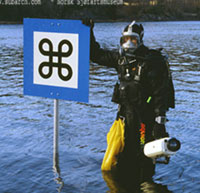History of underwater archaeologyPeople have probably always loved history. Already Herodotus, the Greek historian, was fascinated by past civilizations. The ancient Greek and Romans also believed in a Golden Age in times past, when everything supposedly hade been much better. During the Middle Ages in Europe, this belief continued, letting ancient Rome and Greece represent that lost Golden Age. Early salvage and diving
Using helmet divers, the wreck of Royal George (sunken 1782) was salvaged around 1830, but not for archaeological reasons. The wreck was simply an obstacle that had to be removed. In 1836 the Dean brothers discovered the wreck of Mary Rose, and salvaged a few
objects.
Also, in 1856 the submerged settlement in the Zürich Lake was investigated by divers and historians. The diving archaeologistDuring the following 70 years, many historic ships were salvaged (pillaged) by
divers, but only for commercial reasons. The valuables were sold, and a museum would
get the rusty iron cannon or minor objects such as Roman lead anchors. But there was
no archaeological investigation. The first systematic archaeological underwater investigation was probably the recovery of the Nemi Ships in 1929-32, which ware investigated on land, after being towed ashore. The first case of diving underwater archaeology may have been 1933-39 when the Swedish warship Elefanten (1564) was investigated by helmet divers together with historians. The breakthrough came after World War II. Thanks to the scuba diving equipment developed by Emile Gagnan and Jacques-Yves Cousteau, the underwater world became instantly accessible, and many new ancient wrecks were found at a rapid pace. A pilot case for archaeology with scuba divers was the Grand Congloué wrecks in France, investigated 1951-57 by Cousteau and Fernand Benoît. When the divers started digging down in the layers covered by sand, they first thought it was one wreck, while in fact it was two wreck on top of each other. After the Grand Congloué, many underwater archaeology investigations have been made, by pioneer archaeologists such as Nino Lamboglia, George F. Bass, Peter Throckmorton, and many others. The methods have improved – slowly and tediously even the smallest objects are recorded, as clues to our understanding of people from times past. Even though Cousteau was not an archaeologist, he contributed immensely by promoting popular interest for underwater mysteries.
|




 Back to Nordic Underwater Archaeology
Back to Nordic Underwater Archaeology